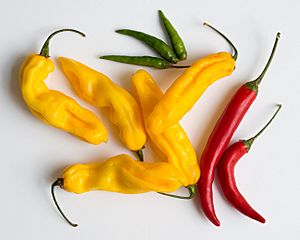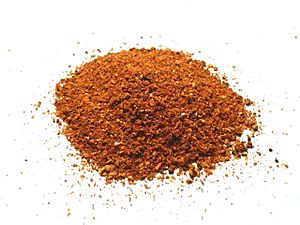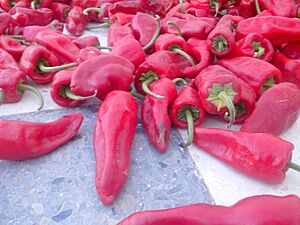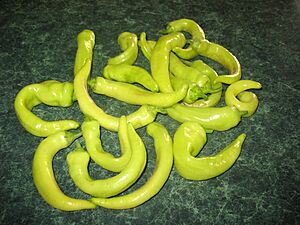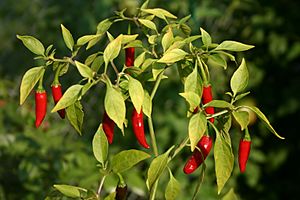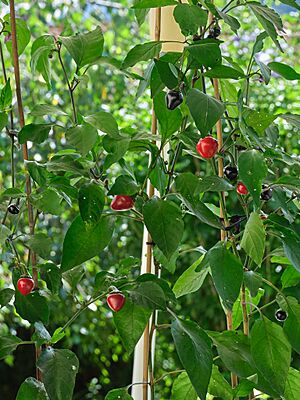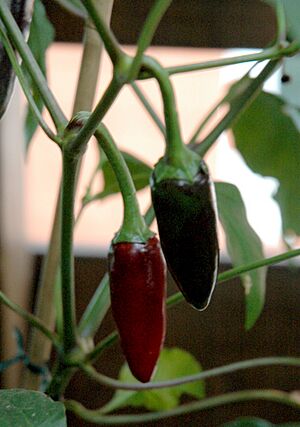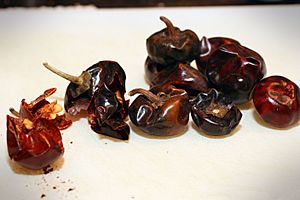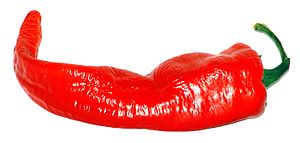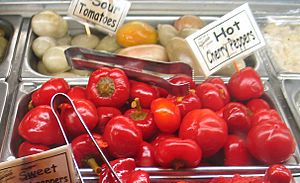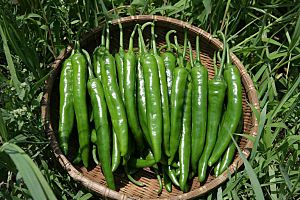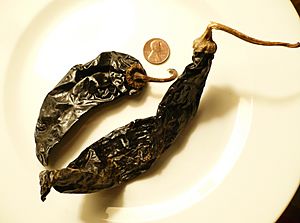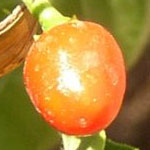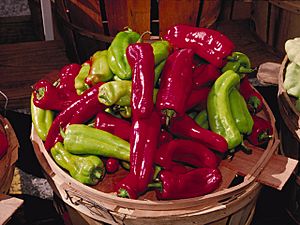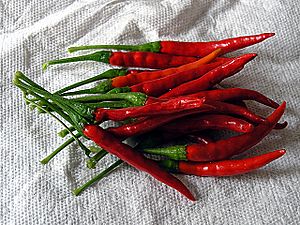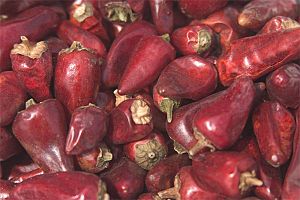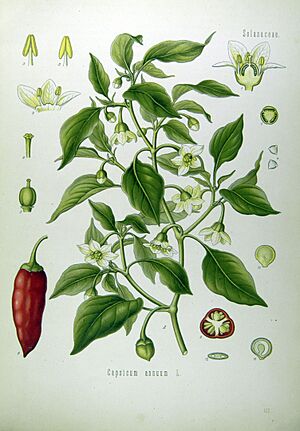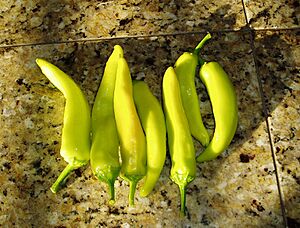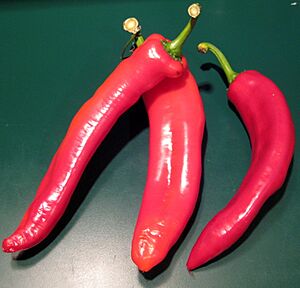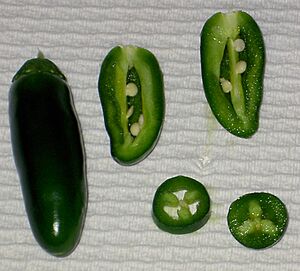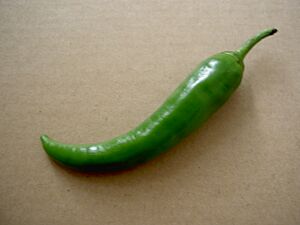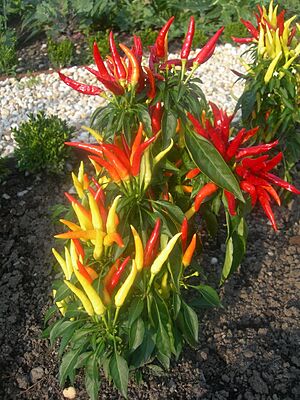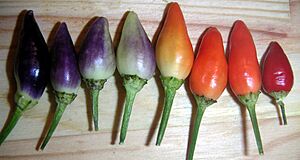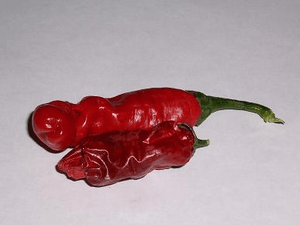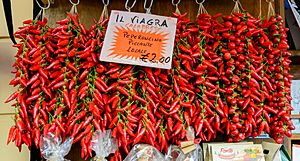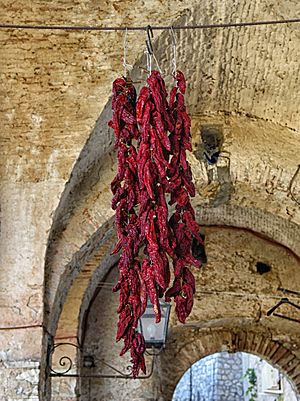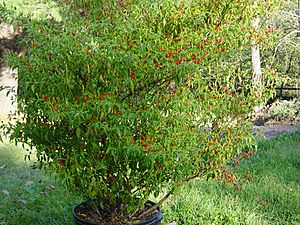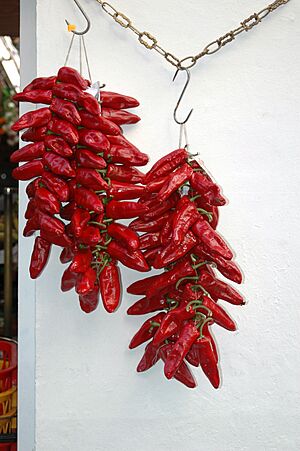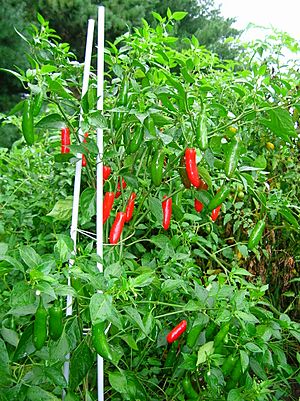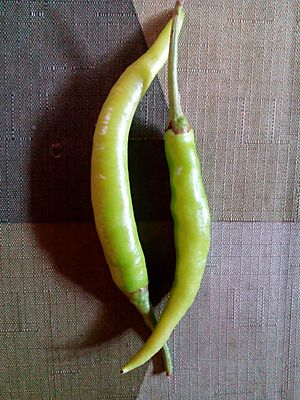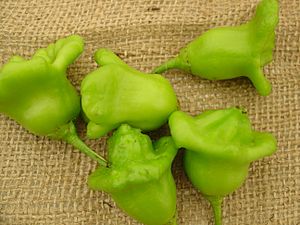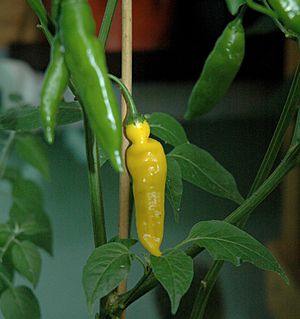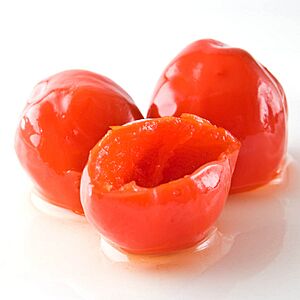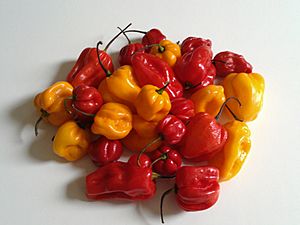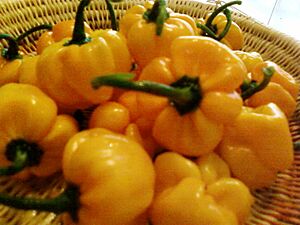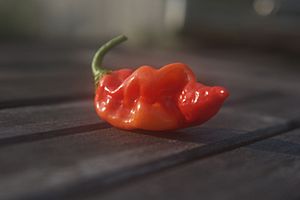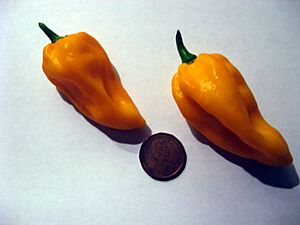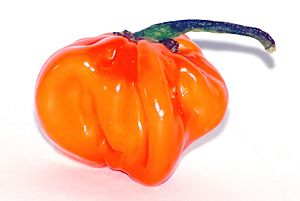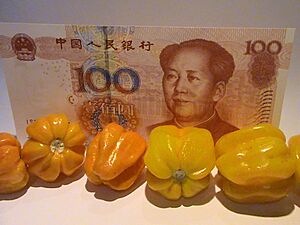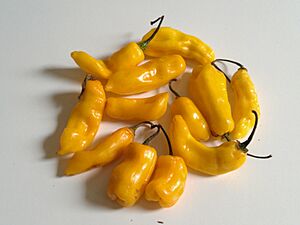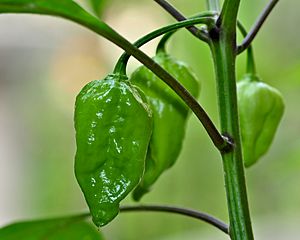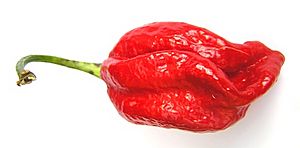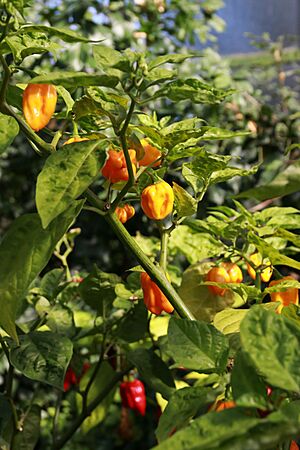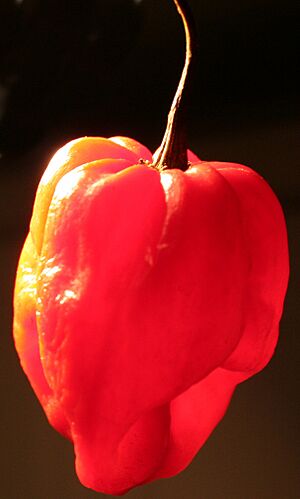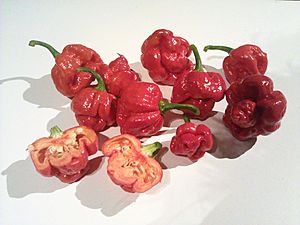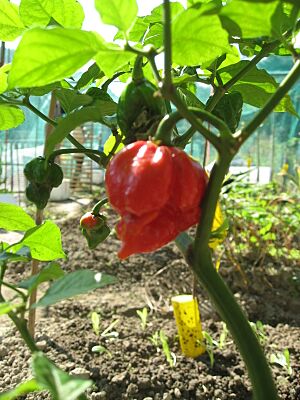List of Capsicum cultivars facts for kids
This article is about the many different types of peppers, also known as Capsicum cultivars. Peppers belong to the plant group called Capsicum. There are five main kinds of cultivated peppers: C. annuum, C. chinense, C. baccatum, C. frutescens, and C. pubescens.
There are about 50,000 different pepper varieties around the world! This list will show you some cool examples, but it's just a small peek at all the amazing peppers out there.
Main Types of Peppers
Scientists believe there are around 50,000 different kinds of peppers grown globally. The United States Department of Agriculture (USDA) has a huge collection of over 6,200 pepper samples. This collection includes many types of Capsicum annuum, which is one of the most common pepper species.
The five main types of cultivated peppers are:
These main types also have many smaller groups, called "varieties." Sometimes, different pepper types can even be crossed to create new kinds!
Popular Pepper Species and Their Varieties
Here are some well-known peppers found within the main species:
- Capsicum annuum: This group includes many familiar peppers like bell peppers, cayennes, Friggitello, jalapeños, paprika, and serrano peppers.
- Capsicum baccatum: These peppers are mostly from South America. Examples include ají amarillo, ají limón, and criolla sella.
- Capsicum chinense: This group is famous for some of the hottest peppers! It includes all the Habaneros, Scotch Bonnets, Trinidad Scorpions, the Bhut Jolokia, and the super-hot Carolina Reaper.
- Capsicum frutescens: This species includes the Tabasco pepper and many peppers grown in India. Sometimes, people don't see it as a separate species from C. annuum.
- Capsicum pubescens: This group includes the Rocoto and Manzano peppers. These plants are special because they have purple flowers, black seeds, and fuzzy dark green leaves. They can grow like big vines, up to 5 meters long!
How New Peppers Are Made
Pepper plants come in many different shapes, colors, and flavors. They are grown for various uses, like spices, vegetables, or even herbal medicines. The word "cultivar" means a plant variety that has been developed and kept by humans.
Some pepper types are called "heirloom varieties." These are old types that people have grown for many years, saving seeds from the best plants each harvest. An example is the California Wonder bell pepper.
Other types are "open-pollinated." This means their seeds are collected after plants have been pollinated naturally, often by wind or insects. While these seeds usually grow into plants that look like the parent, sometimes a little bit of mixing with other pepper types can happen.
"Self-pollinated" varieties are similar, but growers take steps to make sure the plant only pollinates itself. This might involve covering the plant to stop insects from bringing pollen from other plants. This method helps make sure the seeds produce plants that are exactly like the parent.
Hybrid Peppers
"Hybrid" peppers are created when two different self-pollinated pepper types are intentionally crossed. The seeds from this cross grow into a new "hybrid" variety. These hybrid plants are often stronger and produce more peppers than their parent plants.
If you save seeds from a hybrid pepper, they won't grow into plants that are exactly like the hybrid parent. This is why growers have to cross the two original parent plants again each time they want to produce more hybrid seeds. Many of the peppers you see in stores today are hybrid varieties because they have improved traits like higher yields.
Capsicum annuum: The Most Common Peppers
Capsicum annuum peppers originally came from southern North America, Central America, and South America. Native peoples in the Americas have been growing them for thousands of years. Now, they are grown all over the world.
These peppers come in many shapes and sizes. They can be sweet or very hot. Even though they are all the same species, they have many different names. In America, sweet peppers without any heat are often called sweet peppers, and the blocky ones are called bell peppers. Peppers that have heat are called hot peppers or chili peppers. In the UK, sweet ones are "peppers" and hot ones are "chillies." In Australia and India, "capsicum" usually means bell peppers, and "chilli" means the hotter kinds.
The plant itself is a small, bushy plant that can grow from about 1.5 to 5 feet tall. Its white flowers turn into fruit. The fruit is usually green when it's young, but it can also be white. As it ripens, it usually turns red, but some types can ripen to yellow, orange, peach, brown, or purple. These peppers grow best in warm, dry places.
| Image | Name | Type | Origin | Heat | Pod size | Description |
|---|---|---|---|---|---|---|
| Aleppo | Syria and Turkey | 15,000 SHU | Grown in Syria and Turkey. It's used as a spice after being dried and ground. | |||
| Anaheim | Anaheim | United States | 500–2,500 SHU | 15 cm | A mild pepper from New Mexico. It's often used for chile relleno. When ripe, it turns red. | |
| Baklouti | Tunisia | 1,000–5,000 SHU | Grown in North Africa. It is used to make Harissa, a spicy paste. | |||
| Banana | Waxy | 0–500 SHU | 15 cm | Often pickled and used in sandwiches. It's not very hot. Its shape and color look like a banana. | ||
| Bird's Eye | Small hot | Southeast Asia | 50,000–100,000 SHU | 4 cm | A Southeast Asian pepper, often called Thai chili in the US. It has thin fruit with a pointed tip. | |
| Black Heart | Ornamental/Culinary | Austria | 5,000–20,000 SHU | 2–3 cm | Plants can grow up to 1.2 m tall. The flowers are purple. The heart-shaped fruits turn from black to red. | |
| Black Hungarian | Ornamental/Culinary | Hungary | 5,000–10,000 SHU | 5–7 cm | These peppers are cone-shaped. They start green, then turn deep purple or black, and finally ripen to red. | |
| Cascabel | Mexico | 3,000 SHU | 1 inch | Small, round fruits usually dried. They have a nutty flavor. The name means "rattle" because the seeds rattle inside when dried. | ||
| Cayenne (Red) | Cayenne | French Guiana | 30,000–50,000 SHU | 5 inches | This long, thin pepper is used widely in China and India. It's often dried and ground into powder. | |
| Cherry | Pimiento | 100-500 SHU | 1 inch | Named for its small, red, round fruit. It's often used fresh or pickled. It's also called pimento. | ||
| Cheongyang | long, hot | Korea | 10,000 SHU | A medium-sized chili developed in Korea. It's a mix of a local Jejudo chili and a Bird's eye chili. | ||
| Chilaca | Pasilla | Mexico | 1,000–2,000 SHU | 15 cm | Popular in Mexican cooking. When dried, it's called a pasilla. It has a dark brown color and a smoky flavor. | |
| Chiltepin | Chiltepin | Mexico | 50,000–100,000 SHU | 0.5 cm | A small, hot fruit often eaten by birds. It's thought to be the ancestor of many cultivated peppers. | |
| Chimayó | United States | 4,000–6,000 SHU | ||||
| Cubanelle | 1–1,000 SHU | 5 inches | A tapered fruit that is green when young and turns red when ripe. Often fried in Italian cooking. | |||
| Dangjo | Korea | Light green or bright yellow chili peppers with a mild heat. | ||||
| De Árbol | Mexico | 15,000–30,000 SHU | 8 cm | This slender pepper is grown mainly in Mexico. Its name means "from a tree" in Spanish. | ||
| Facing Heaven | Pimiento | China | 30,000-50,000SHU | |||
| Fish | 5,000–30,000 SHU | |||||
| Fresno | Fresno | United States | 2,500–10,000 SHU | 9 cm | Similar to a jalapeño but with thinner walls. It's often used ripe and in salsa. | |
| Friggitelli (Peperoncini) | Waxy | Italy | 100–500 SHU | 8 cm | Sweet and mild, used a lot in Italian and Greek food. Often pickled. | |
| Guntur chilli | 30,000–350,000 SHU | A well-known pepper used as a spice, food addition, or vegetable. | ||||
| Hungarian Wax | Waxy | 2,500–8,000 SHU | A wide, medium-hot pepper used in Hungarian food. Often pickled, dried, and ground into "paprika". | |||
| Italian Sweet | Long, sweet | Italy | Used in Spanish cooking. | |||
| Jalapeño | Jalapeño | Mexico | 2,500–8,000 SHU | 9 cm | Very popular, especially in the US. Often pickled or canned. A smoke-dried ripe jalapeño is called a chipotle. | |
| Korean chili | Korea | 1,500 SHU | 3–4 inches | Also known as "Korean Dark Green" or "Korean Hot." | ||
| Medusa | Ornamental | A sweet, decorative chili pepper that grows upright and has bright fruits. | ||||
| Mirasol | Mexico | 2,000–5,000 SHU | The dried version of the Mirasol chili is called guajillo. It's used to make a red sauce for tamales. | |||
| NuMex peppers | Ornamental | United States | The Chile Pepper Institute at New Mexico State University has created many unique chili types. NuMex Twilight peppers are shown here. | |||
| Peter Pepper | Ornamental | United States and Mexico | 5,000–30,000 SHU | 8–10 cm | A rare, old-fashioned hot pepper grown for its unique shape. | |
| Peperoncino | Cayenne | Italy | 15,000–30,000 SHU | A general Italian name for hot chili peppers, especially those from Capsicum annuum and Capsicum frutescens. | ||
| Peperone crusco | Sweet | Italy | 0 SHU | Italian name for a crispy, dry, and sweet pepper from the Basilicata region. | ||
| Pequin | Small Hot | Mexico | 100,000–140,000 SHU | Also spelled piquín. | ||
| Piment d'Espelette | Pimiento | Basque Country (French part) | 1,500 - 2,500 SHU | Fresh fruits are known as "Gorria," which means "red" in Basque. Grown in Espelette since about 1650. | ||
| Padrón | Pimiento | Spain | 500–5,000 SHU | 3.5–6 cm | Sometimes called pimientos de Herbón. Most are mild, but about 1 in 10 can be quite hot. | |
| Poblano | Poblano | Mexico | 1,000–2,000 SHU | 13 cm | A large, heart-shaped, dark green pepper very popular in Mexico. Often used for chile relleno. When dried early, it's called an ancho. When fully ripe and dried, it's a mulato. | |
| Prik Kee Nu | Small Hot | Thailand | 50,000–100,000 SHU | 3 cm | One of many peppers called Thai pepper. It has very short fruit and is very hot. Its Thai name means "mouse/rat dropping chili." | |
| Puya | Mexico | 5,000 SHU | A hot, medium-sized pepper that changes from green to red. Also known as a 'Pulla'. | |||
| Santa Fe Grande | Fresno | A very productive pepper used in the Southwestern US. The conical fruits change from greenish-yellow to orange-yellow to red. They grow upright on 24-inch plants. It has a slightly sweet taste and is fairly mild. | ||||
| Serrano | Serrano | Mexico | 10,000–23,000 SHU | 5 cm | A thin, tapered fruit that turns red when ripe. It doesn't need to be peeled before use. | |
| Shishito | Japan | 50-200 SHU | ||||
| Siling Mahaba | Philippines | 50,000 SHU | A chili pepper grown in the Philippines and a popular ingredient in Filipino Cuisine. |
Capsicum baccatum: Fruity Flavors
These peppers have a special, fruity flavor. They are often ground into colorful powders for cooking, and each powder is known by its color.
| Image | Name | Origin | Heat | Pod size | Description |
|---|---|---|---|---|---|
| Bishop's Crown | 10,000–30,000 SHU | 6 cm | A C. baccatum type from Barbados. These medium-hot peppers have a unique shape that looks like a bishop's hat. They are strong plants and can grow for many years. | ||
| Lemon Drop | 30,000–50,000 SHU | 4 cm | A very productive C. baccatum type. The peppers have thin walls and a fruity taste with medium heat. | ||
| Piquante pepper | 1,000–2,000 SHU | 2 cm | Mild, sweet, and tangy flavor, good for many dishes. |
Capsicum chinense: The Super Hots
The name Capsicum chinense or "Chinese capsicum" is a bit misleading. All Capsicum species actually came from the New World (the Americas). A Dutch botanist named Nikolaus Joseph von Jacquin gave them this name in 1776 because he thought they came from China. Most peppers in this group have a distinct flavor that is similar to each other.
| Image | Name | Origin | Heat | Pod size | Description |
|---|---|---|---|---|---|
| Adjuma | 100,000–500,000 SHU | Very hot, first grown in Suriname. | |||
| Ají Dulce | 0–500 SHU | A type of seasoning pepper. It's related to the habanero but much milder. | |||
| Bhut Jolokia | Northeast India | Up to 1,040,000 SHU | 6 cm | This pepper was once the hottest in the world, according to Guinness World Records. It's a mix of C. chinense and some C. frutescens genes. Also known as naga jolokia and ghost pepper. | |
| Carolina Reaper | United States | 1,569,300–2,200,000 SHU | An extremely hot pepper. It became the Guinness World Record holder for hottest chili on August 7, 2013. It was developed from the Bhut Jolokia. | ||
| Datil | 100,000–300,000 SHU | A very hot chili, mostly grown in Florida. | |||
| Fatalii | 125,000–325,000 SHU | 6 cm | Grown in central and southern Africa. It looks very similar to the devil's tongue habanero. | ||
| Habanero | 100,000–350,000 SHU | 5 cm | Once thought to be the hottest chili, but now other varieties are hotter. Still, it's much hotter than most common peppers. It has a fruity flavor and a floral smell. Spanish and Portuguese explorers brought it to China over 500 years ago. | ||
| Hainan Yellow Lantern | 300,000 SHU | 5 x 3 cm | Also known as the yellow emperor chili. It grows only in Hainan, China. | ||
| Infinity chili | 1,176,182 SHU | ||||
| Madame Jeanette | 100,000–350,000 SHU | First grown in Suriname. | |||
| Naga Morich | Bangladesh and India | 1,000,000 SHU | |||
| Naga Viper | England | 1,382,118 SHU | |||
| NuMex peppers | United States | The Chile Pepper Institute at New Mexico State University has created many unique chili types. NuMex Suave Orange peppers are shown here. | |||
| Red Savina | United States | 200,000–580,000 SHU | |||
| Scotch Bonnet | 150,000–325,000 SHU | 5 cm | Named because it looks like a Tam o' Shanter hat. It's related to the habanero and is similarly hot. Used often in Caribbean cooking. | ||
| Trinidad moruga scorpion | Up to 2,000,000 SHU | Was the world-record holder for hottest chili in 2012. | |||
| Trinidad Scorpion 'Butch T' | Up to 1,400,000 SHU | Was a former world-record hottest chili. |
Capsicum frutescens: Indian and Tabasco Peppers
Sometimes, this species is considered the same as C. annuum.
| Image | Name | Origin | Heat | Pod size | Description |
|---|---|---|---|---|---|
| African Birdseye | Mozambique | 50,000–175,000 SHU | 1 inch | Also known as piri piri. It's common in Portuguese, Mozambican, and Angolan foods. | |
| Kambuzi | Malawi | Kambuzi is a small, round chili pepper found in Malawi, Africa. | |||
| Siling Labuyo | Philippines | 80,000–100,000 SHU | 1 inch | A small, cone-shaped pepper grown in the Philippines. | |
| Tabasco | Mexico | 30,000–50,000 SHU | 4 cm | Used to make Tabasco sauce. The fruit is only used when it reaches a specific red color. | |
| Xiao mi la pepper | China | 75,000 SHU | The name xiao mi la means "little rice chili" in English. It's one of the three most common peppers in Chinese cooking. |
Capsicum pubescens: Old and Unique Peppers
Capsicum pubescens is one of the oldest types of domesticated peppers. People were growing it as far back as 5,000 years ago! It's likely related to wild plants that still grow in South America.
| Image | Name | Origin | Heat | Pod size | Description |
|---|---|---|---|---|---|
| Canário | Peru | 30,000–50,000 SHU | 6.5 cm | Canário is a medium-hot C. pubescens type. Its thick-walled peppers are dark yellow when ripe and are about the size of a small apple. This South American type grows well in cool conditions and can be grown for many years. | |
| Rocoto | Peru, Bolivia | 30,000–100,000 SHU | Also known as a Manzano or Locoto pepper. "Manzano" means "apple" in Spanish, which describes the fruit's shape. Notice its unique black seeds! |


